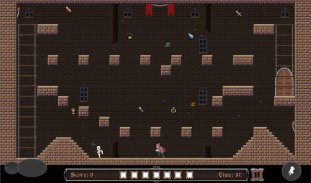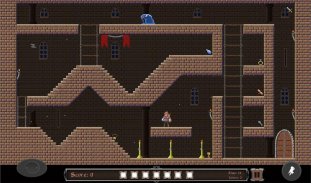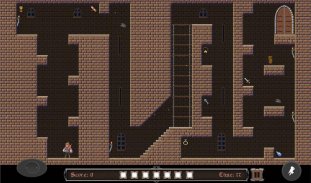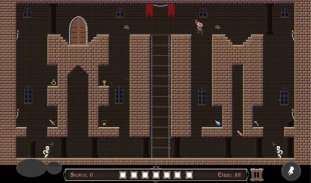






Sir Lancelot Quest

Descrizione di Sir Lancelot Quest
Sir Lancelot Quest is a platform game inspired by the game published in the 80s for amstrad CPC and ZX spectrum home computers, but with graphics and updated content, with an air pixel art, which gives it those retro times.
The player will control Sir Lancelot, who must explore the 24 rooms of the castle, and collect all the objects in each room to open the door, and exit to the next room. Your task will be hampered by the presence of enemies and think how to perform the movements with stairs only rise, and placement of the elements. The dynamics of the enemies, screens and situation of the objects, follows the patterns of the original game released for amstrad CPC and ZX spectrum. You also have a time to complete each room, if this time runs out, depending on the game mode, you will lose the game and you must start the room from the beginning.
The game consists of two game modes:
- The story mode that follows the patterns of mobile games, avoiding the way to play retro, where you can repeat as many times as you want each level, and you will open the next ones as you complete the previous one.
- The survival mode, has all the retro character of the game, where we will have 3 lives, and advance through the screens sequentially, as was the case in the original version of ZX spectrum. When you lose all three lives, you must start from the first screen.
The control of the game is simple, there are only the three operations of the retro game of amstrad CPC and ZX spectrum, moving the character to the right or left, and being able to jump.
In the survival mode, the rooms are visited as in the ZX spectrum version, progressively, while the story has it as the amstrad CPC verison, which allows the rooms to be completed in order but can be repeated. Also in the survival mode, to give it the most retro character, it consists, as in amstrad CPC, of a higher score.
Enjoy, remembering your games to this magical version, one of the greatest hits of the 80s for personal computers.
Sir Lancelot Quest è un gioco di piattaforme ispirato al gioco pubblicato negli anni '80 per i computer amstrad CPC e ZX dello spettro, ma con grafica e contenuti aggiornati, con una grafica a pixel d'aria, che gli conferisce quei tempi retrò.
Il giocatore controllerà Sir Lancelot, che deve esplorare le 24 stanze del castello e raccogliere tutti gli oggetti in ogni stanza per aprire la porta ed uscire nella stanza successiva. Il tuo compito sarà ostacolato dalla presenza di nemici e penserai a come eseguire i movimenti con le sole scale e il posizionamento degli elementi. Le dinamiche dei nemici, gli schermi e la situazione degli oggetti, seguono gli schemi del gioco originale rilasciato per lo spettro di amstrad CPC e ZX. Hai anche un tempo per completare ogni stanza, se questo tempo si esaurisce, a seconda della modalità di gioco, perderai la partita e dovrai iniziare la stanza dall'inizio.
Il gioco consiste in due modalità di gioco:
- La modalità storia che segue gli schemi dei giochi mobili, evitando il modo di giocare in stile retrò, in cui puoi ripetere tutte le volte che vuoi ogni livello, e aprirai i successivi mentre completi il precedente.
- La modalità di sopravvivenza, ha tutto il carattere retrò del gioco, dove avremo 3 vite, e avanzeremo attraverso gli schermi in sequenza, come nel caso della versione originale dello spettro ZX. Quando perdi tutte e tre le vite, devi iniziare dalla prima schermata.
Il controllo del gioco è semplice, ci sono solo le tre operazioni del gioco retro di amstrad CPC e dello spettro ZX, spostando il personaggio a destra o sinistra e potendo saltare.
Nella modalità di sopravvivenza, le stanze vengono visitate come nella versione dello spettro ZX, progressivamente, mentre la storia ha come la versione CPC di Amstrad, che consente di completare le stanze in ordine, ma può essere ripetuta. Anche in modalità sopravvivenza, per conferirgli il carattere più retrò, consiste, come nel CPC di amstrad, di un punteggio più alto.
Divertiti, ricordando i tuoi giochi con questa versione magica, uno dei più grandi successi degli anni '80 per i personal computer.




























